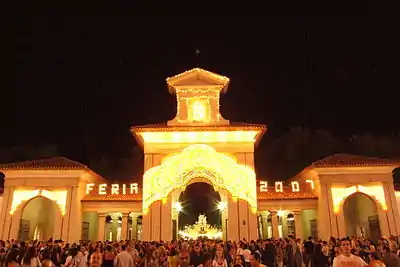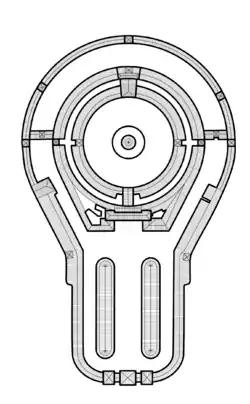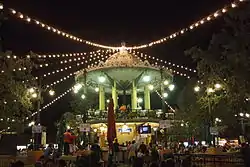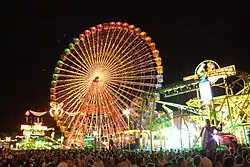Albacete Fair
Fair of Albacete is a fair celebrated from 7–17 September in the city of Albacete, Spain, to honor the Virgen de los Llanos. It was declared Festivity of international interest,[1] it takes place in the permanent fairground commonly known as 'the pan' or 'the circles' situated near the centre of the city. It has a very well-known bullfighting activities and hundred of other takes place during the days, and the city gets to quadruple its inhabitants during the festivity.[2]

The first news that we have about the annual fair in the city of Albacete date back of the first decade of 1200. Its importance was increasing during the centuries, which led the Catholic Monarchs to recognize it. But without any doubt, the most historical date for the fair and the city was the 6 March 1710 during the Spanish war of succession, the first Borbon, Felipe V, gave the city the privilege of realizing an annual franc fair for the length of four days in which year by year turn into ten as in the actual times.
In 1783 the fairground building were built in the actual location. It has a 'pan' shape and it is an example of manchegan architecture towards a commercial goal. The body of the pan has some concentric rings which held the commercial stands.
History

As precedent of it, there were found some testimonies of the 15th century which talks about a regular market held in Feria' Street. This street still preserves its name until our days, linking the San Juan's Cathedral with the Santa Catalina's plains, where now stands the Fairground Building. In that place cattle were sold back in the days. The market lasted for 10 days, which started from 30 November, and later on from 28 August.
In the 17th century it was moved outside the centre of the city, as an economic activity parallel to the parade that took place every 8 September to the place of Los Llanos. There, near the chapel of the Virgin, was found in 1672 a Franciscan convent that took an important role in that time. In 1683 it was requested to the king Carlos III his declaration of the franc fair for 3 days (7, 8 and 9 September) and its location in the convent proximities, in the place of Los Llanos, because it increases the chances of getting alms.
Even though this request was not fulfilled, 6 March 1710, Philip V gave the city the privilege of a franc fair for 4 days (from 7 to 11 September). And the city hall disposed that it should take place in the urban center, in the Main Street and the Main Square, but the traders still went to the place of Los llanos. During the period from 1710 and 1712, which is defined as the divided fair, it was celebrated 2 days in the place commanded by the city hall, and the rest in the former place near the Franciscan convent.
The attempts to take the fair back to Albacete drove the city Hall to buy some market building to build the Fairground Building, but this project never took place, but in 1783 there was an agreement to build in the Plain of Santa Catalina those buildings. This was inaugurated 7 September 1783, and completely finished the next year. From that tate, the fair was held in the urban center of Albacete. Lately the Fairground Building was object of many ampliations and reforms. The last one date of 2010 due to the 300th anniversary.
The fair did not take place during the years 1937 and 1938 due to the Spanish civil war.[3]
Alterations of the Fairground Building

During the time of its inauguration in 1783, the building, built during only 33 days following the sketch of the Spanish architect Josef Ximenez, consisted only in the exterior walls and the interior circle. It was totally finished on the following year, 1784.
Among the alterations and ampliations which took place in the Fairground Building from its beginnings, we emphasize: [4]
- In 1876 the columns of the central circles were replaced by the iron ones of nowadays.
- in 1876 the columns of the inner circles were changed into the current iron ones.
- Until 1877, there was a fountain in the center, which was really important for the cattle that was gathered in the fair. That year the fountain was removed and substituted by a kiosk.
- In 1912 the modernist kiosk was built, since restored, which we can still see.
- In 1944 some major work was done to make the building bigger, adding a third circle to the Pan, the exposition room and two more saloons at the entrance.
- In 1974 the neoclassic façade was changed into the white bricks one, following the design of the architect Manuel Carrilero.
- Between 2008 and 2010, due to the III Century anniversary, major improvements were made, also in the surrounding areas, subterranean parking under the "Paseo".".[5] One of the major improvements was a new iron gate, similar to the old one on the entrance of Los Jardinillos, in front of the Bullfighting ring.
Opening Parade

It is the first and most important event of La Feria. Its mission is to take the image of the virgin of Los Llanos to the Recinto Ferial, finishing with the opening of the main gate (Puerta de Hierros) of said building. This opening is carried out during the night since 1909. Until this year, it was performed in the morning.[6]
In the parade there is about 100 floats together with brass bands and manchegas with the typical costumes. The parade starts in Avenida de España and finishes in the main gate of the Recinto ferial, when the mayor of the city opens the gate and fireworks are shot. In 2008 the fireworks were replaced by a light and sound spectacle. projected at the gates. This is the official opening of the fair. After that, the image of the Virgen de Los Llanos is taken to her chapel, where it will be for the next 10 days.
Floral offering
It is an act organized by the Peña Templete since 1989. Almost 20,000 people participate in it the first Sunday of the fair. The offering starts in the cathedral and ends at the gate of the Chapel inside the Recinto Ferial. In its balcony, the image of the Virgen is represented.
Traditions and plances
The distribution of the Fair has different parts:
- The walk
At the beginning of the walk, several tombolas and games are installed. It is well known the Cáritas Tombola, traditionally managed by Cáritas for benefic causes. Its prices are donated and workers and volunteers do the jobs. Its origin starts in 1953, when it was created to build houses for the working-class people. After the tombolas, there's a children attractions area, and at the end some food marquees.
- Los Ejidos

After the walk, we enter to a place surrounding the Recinto Ferial, where back in the days cattle was sold. It lost that use when the machinery was started to use in the fields.
Nowadays, starting on the right side, we find mobile companies and television's stalls, a music marquee, and other bigger attractions. If we keep walking we find the marquees for rock music that every day hold free concerts. Around the fair building we find some other craftwork and toys marquees.
- The Inner Circle
Every day there's party in the fair building, specially in the inner circle where, until 2007, every early morning, the toro de fuego of Barrax make the fun last. This bull was a cart hold by a person with some firecrackers in the horns. It was removed due to its potential danger.
If we want to keep the party on, the marquees located in Los Ejidos are still open until the early morning. At the end of the main walk of the pan, there are several stands where different associations and commerce make their exhibitions of products from different parts of Castilla la Mancha. One of the typical things of La Feria, are the Miguelitos de la Roda, a puff pastry filled with custard and pouder sugar on top.
There is also a big knife exhibition opened to the public with great art pieces of the knife's Albacetenian industry. A custom very extended among families in Albacete is the feriar something to kids and friends, which is, making a present after walking along the market place of La Feria.
Notes and references
- Albacete y su feria, ligadas en el tiempo. Portal de Noticias La Cerca (19-09-2007)
- Varios autores. Libro del III centenario Feria de Albacete (número 1). Editora municipal. Albacete, 2007. ISBN 978-84-921720-9-2
References
- "La Feria de Albacete consigue la declaración de Interés Turístico Internacional. La Verdad". Archived from the original on 2014-04-28.
- "El alcalde confirma que la Feria de Albacete del 2007 ha sido la más visitada y participativa de su historia (diario La Verdad 18-9-2007)". Archived from the original on 2009-09-04. Retrieved 2010-09-14.
- "Una Cabalgata sin la Patrona. Diario La Verdad (7-9-2006)". Archived from the original on 2009-09-03. Retrieved 2010-09-14.
- "Fechas para la Feria. Artículo del especial del Diario La Verdad para la feria 2004". Archived from the original on 2007-04-21. Retrieved 2010-09-14.
- "Archived copy". Archived from the original on 2010-09-18. Retrieved 2010-09-14.CS1 maint: archived copy as title (link)
- "La Feria de 1927 se abrió de noche. Especial feria de Albacete 2007.Diario La Verdad". Archived from the original on 2011-07-19. Retrieved 2010-09-14.
External links
- Tres artículos sobre la historia de la Feria de Albacete, desglosada año a año.
- Carteles de Feria desde 1901 hasta nuestros días
- Fotos históricas de la Feria
- Web sobre la Feria de Albacete en Albacity desde 2003
- Web oficial de la Feria de Albacete
- Web sobre el Centenario de la Feria
| Wikimedia Commons has media related to Feria_de_Albacete. |